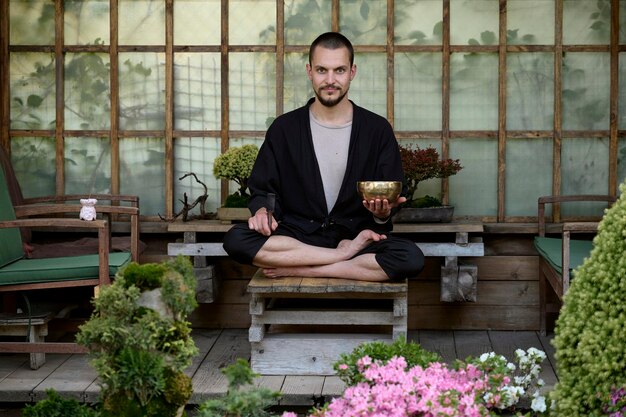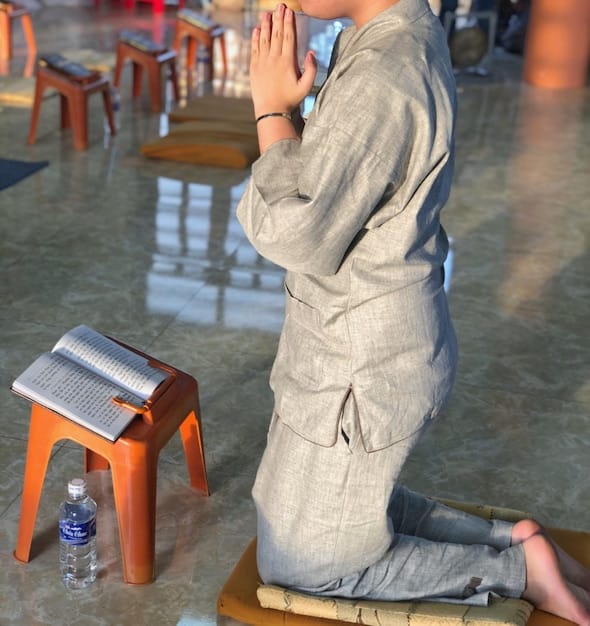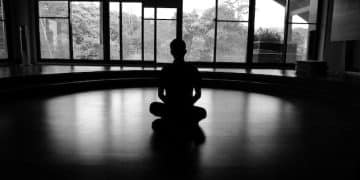Zen Meditation (Zazen): Your Practical Guide to Mindfulness & Awareness

Zen Meditation (Zazen) is a traditional practice focused on cultivating mindfulness and awareness through structured sitting meditation, guiding practitioners towards deeper self-understanding and inner peace.
Embark on a journey of self-discovery and tranquility with Zen Meditation (Zazen). This guide offers practical, step-by-step instructions to help you achieve mindfulness and awareness through the transformative practice of sitting meditation.
Understanding Zen Meditation (Zazen)
Zen Meditation, also known as Zazen, is a core practice in Zen Buddhism. It emphasizes direct experience and insight, aiming to quiet the mind and promote a state of present-moment awareness. Unlike some other meditation techniques that involve guided visualizations or mantras, Zazen focuses on simply observing thoughts and sensations without judgment.
The Roots of Zazen
Zazen has deep roots in Buddhist history, tracing back to the teachings of Siddhartha Gautama, the Buddha. Over centuries, it evolved through various schools of Buddhism, solidifying its role as a central practice for attaining enlightenment. Its core principles remain consistent: cultivating mindfulness, awareness, and a deeper understanding of oneself and the nature of reality.
Key Principles of Zen Meditation
The essence of Zazen lies in several key principles: mindful awareness of breath, maintaining a stable and upright posture, and observing thoughts and emotions without getting carried away by them. It’s about fostering a non-judgmental attitude, allowing experiences to arise and pass without clinging or resistance. This process helps practitioners develop greater insight, concentration, and equanimity.
- Mindfulness: Paying attention to the present moment without judgment.
- Posture: Maintaining a stable, upright position to support alertness.
- Non-judgment: Observing thoughts and feelings without criticism.
- Breath Awareness: Using the breath as an anchor to the present.
In essence, Zen Meditation is a direct path to self-discovery, promoting inner peace and a clearer understanding of the mind. By consistently practicing Zazen, individuals can develop greater resilience, compassion, and wisdom.

Preparing for Your Zazen Practice
Proper preparation is essential for a successful Zazen practice. This involves finding a quiet and comfortable space, dressing appropriately, and gathering the necessary equipment. By setting the stage effectively, you create an environment conducive to focus and relaxation, maximizing the benefits of your meditation.
Finding the Right Space
Choose a location that is free from distractions and noise. This could be a quiet room in your home, a peaceful garden, or any space where you feel safe and undisturbed. Ensure the area is clean and uncluttered to promote a sense of calm. Consistency is key; using the same space for your practice can help you mentally prepare and deepen your meditative state over time.
Comfortable Clothing and Equipment
Wear loose, comfortable clothing that allows you to move freely without restriction. Avoid tight or binding garments that might distract you during meditation. A traditional Zafu (cushion) and Zabuton (mat) can provide additional support and comfort, helping you maintain proper posture. If you don’t have these, a folded blanket or a firm pillow can serve as effective alternatives.
Setting the Intention
Before you begin, take a moment to set an intention for your practice. This could be as simple as a commitment to be present and mindful, or a specific goal such as reducing stress or cultivating compassion. Setting an intention helps focus your mind and provides a sense of purpose for your meditation session.
Preparing both the environment and your mindset sets the stage for a deeper and more meaningful Zazen practice. With a quiet space, comfortable attire, and a clear intention, you can create a foundation for cultivating mindfulness and inner peace.
Mastering the Zazen Posture
The Zazen posture is fundamental to the practice, supporting both physical stability and mental alertness. While it may seem challenging at first, with practice and patience, you can find a posture that is both comfortable and effective. The goal is to maintain an upright, yet relaxed position that promotes focus and reduces physical discomfort.
Full Lotus, Half Lotus, and Burmese Position
The full lotus position involves placing each foot on the opposite thigh, while the half lotus places one foot on the opposite thigh and the other tucked beneath. The Burmese position is a more accessible alternative, with both feet resting on the floor in front of you, one slightly ahead of the other. Choose the position that best suits your flexibility and comfort level, but remember that it’s okay to simply sitcross legged!
Using a Zafu and Zabuton
A Zafu (meditation cushion) helps elevate your hips, making it easier to maintain an upright posture and reducing strain on your knees and back. Place the Zafu on a Zabuton (mat) for added cushioning and support. Adjust the height of the Zafu as needed to find the optimal position for your body. If you not a cushion user, sitting in a sturdy chair with a straight back is also acceptable.
Hand and Eye Position
Your hands should rest gently in your lap, with your left hand resting on top of your right, palms facing upwards. The tips of your thumbs should lightly touch, forming an oval shape. This hand position, known as the cosmic mudra, helps maintain energy flow and focus. Keep your eyes slightly open, gazing softly at the floor about two to three feet in front of you. Alternatively, you can close your eyes entirely, but keeping them slightly open can help prevent drowsiness.
- Full Lotus: Feet on opposite thighs (advanced).
- Half Lotus: One foot on opposite thigh (intermediate).
- Burmese: Feet on the floor, one slightly ahead (beginner-friendly).
- Chair Position Feet flat on the floor, maintaining proper posture.
Finding the right Zazen posture involves experimentation and self-awareness. Listen to your body, make adjustments as needed, and be patient with yourself. With consistent practice, you’ll develop a posture that supports your meditation and enhances your overall well-being.

The Art of Breath Awareness in Zazen
Breath awareness is a cornerstone of Zazen meditation, serving as an anchor to the present moment. By focusing on the natural rhythm of your breath, you can quiet the mind, reduce distractions, and deepen your meditative state. The practice involves observing your breath without trying to control or change it, simply being aware of each inhalation and exhalation.
Observing the Natural Rhythm of Breath
Allow your breath to flow naturally, without forcing or manipulating it. Notice the sensation of the air entering and leaving your body, paying attention to the subtle movements in your abdomen, chest, and nostrils. Whether your breath is shallow or deep, fast or slow, simply observe it without judgment or analysis. Avoid trying to alter your breathing pattern; the goal is to be present with your breath as it is.
Dealing with Distractions
It’s natural for your mind to wander during meditation. When you notice your thoughts drifting, gently acknowledge them without getting carried away, and then redirect your attention back to your breath. Visualize the wayward thoughts as clouds that pass and fade away.
Using Breath Counting (Optional)
If you find it challenging to maintain focus on your breath, you can try breath counting. Count each inhalation and exhalation up to a certain number (e.g., ten), and then begin again. This technique provides a structured way to anchor your attention and reduce mental distractions. However, avoid becoming overly focused on the counting itself; the primary goal is to remain aware of your breath.
Mastering breath awareness in Zazen requires patience and practice. By consistently returning your attention to your breath, you can cultivate a calm, focused mind and deepen your connection to the present moment. It’s a simple yet powerful practice that can transform your meditation experience and enhance your overall sense of well-being.
Navigating Thoughts and Emotions
During Zazen meditation, thoughts and emotions will inevitably arise. The key is not to suppress or judge them, but rather to observe them with detached awareness. By allowing thoughts and emotions to come and go without getting caught up in them, you can cultivate a sense of inner peace and clarity.
Acknowledging Thoughts and Emotions
When you notice a thought or emotion arising, simply acknowledge its presence without labeling it as good or bad. Observe its characteristics – its intensity, its duration, and its effect on your body and mind. Avoid getting drawn into the storyline of the thought or the emotional reaction. Instead, maintain a detached perspective, viewing the thought or emotion as a temporary mental event.
The Power of Non-Judgment
One of the most important aspects of navigating thoughts and emotions in Zazen is practicing non-judgment. Avoid criticizing yourself for having certain thoughts or feeling certain emotions. Remember that thoughts and emotions are natural phenomena that arise and pass away on their own. Your task is simply to observe them without adding any additional judgment or interpretation.
Returning to the Present Moment
Whenever you find yourself getting carried away by a thought or emotion, gently redirect your attention back to the present moment. Focus on your breath, your posture, or the sensations in your body. This grounding technique helps you break free from the cycle of mental reactivity and return to a state of mindful awareness.
Learning to navigate thoughts and emotions in Zazen is a process that unfolds over time. Be patient with yourself, practice regularly, and remember that the goal is not to eliminate thoughts and emotions, but to change your relationship to them. With consistent practice, you can cultivate a sense of inner peace and equanimity, even in the face of challenging mental and emotional experiences.
Integrating Zen Meditation into Daily Life
While Zazen meditation is traditionally practiced in a formal setting, its principles can be integrated into your daily life to cultivate mindfulness and awareness in all aspects of your experience. By bringing the qualities of Zazen – presence, non-judgment, and breath awareness – into your everyday activities, you can deepen your practice and enhance your overall sense of well-being.
Mindful Activities
Choose everyday activities, such as walking, eating, or washing dishes, and practice doing them with full attention. Focus on the sensory details of the experience – the feel of your feet on the ground, the taste of your food, the warmth of the water on your hands. Avoid multitasking or getting distracted by thoughts and emotions. Instead, immerse yourself fully in the present moment.
Short Bursts of Meditation
Incorporate brief meditation breaks into your workday or daily routine. Even a few minutes of mindful breathing can help you reset your mind, reduce stress, and improve focus. Find a quiet space, sit comfortably, and focus on your breath. Let go of any expectations or goals, and simply allow yourself to be present.
Cultivating Compassion
Extend the qualities of Zazen – non-judgment, acceptance, and presence – to your interactions with others. When you encounter difficult people or challenging situations, practice observing your reactions without judgment. Cultivate compassion for yourself and others, recognizing that everyone is doing their best with the resources they have.
Integrating Zen Meditation into daily life is an ongoing process of self-discovery and transformation. By bringing mindfulness and awareness into all aspects of your experience, you can cultivate a deeper sense of peace, joy, and connection to life.
| Key Point | Brief Description |
|---|---|
| 🧘♀️ Proper Posture | Upright but relaxed position using a cushion or chair. |
| 🌬️ Breath Awareness | Focus on the natural rhythm of your breath. |
| 🤔 Non-Judgment | Observe thoughts and emotions without labeling them. |
| 🌱 Daily Integration | Apply mindfulness to activities like walking or eating. |
Frequently Asked Questions (FAQ)
▼
Typically, a Zazen session lasts between 20 to 40 minutes. Beginners can start with shorter durations and gradually increase the time as they become more comfortable. Consistency is more important than session length.
▼
No, the lotus position is not mandatory. You can sit in a half-lotus, Burmese position, or even on a chair with your feet flat on the floor. The most important thing is maintaining a stable and upright posture that feels comfortable.
▼
If you experience pain, gently adjust your posture. If the pain persists, end the session. It’s important to listen to your body and avoid pushing yourself too hard, especially when starting. Gradually build flexibility over time.
▼
Ideally, practice Zazen daily. Even short sessions of 10-15 minutes can be beneficial. Regular practice helps cultivate mindfulness, reduce stress, and foster a sense of inner peace. Consistency trumps intensity in meditation.
▼
Yes, Zazen is a non-religious practice that can be beneficial for people of all backgrounds. It focuses on universal principles such as mindfulness, awareness, and presence, which are compatible with various belief systems.
Conclusion
By following this guide and incorporating Zen Meditation (Zazen): A Practical Guide to Sitting Meditation for Mindfulness and Awareness into your daily routine, you can unlock many opportunities for self-discovery and inner tranquility. Remember to be patient with yourself, practice regularly, and approach each session with a spirit of openness and curiosity. The journey to mindfulness and awareness is a personal one, and the benefits are well worth the effort.





